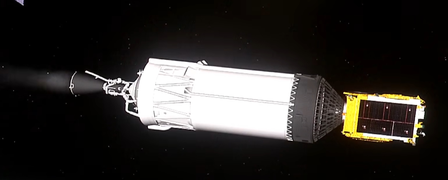
Sriharikota (Andhra Pradesh), Nov 2 (IANS) — The Indian Space Research Organisation (ISRO) on Sunday successfully achieved the separation and orbital injection of the Indian Navy’s GSAT-7R (CMS-03) communication satellite, marking another major step in strengthening India’s maritime communication and surveillance capabilities.
Launched aboard the LVM3-M5 rocket from the Satish Dhawan Space Centre in Sriharikota at 5:26 p.m., the GSAT-7R is the most advanced communication satellite ever developed for the Indian Navy. In an official update, ISRO confirmed on X (formerly Twitter): “CMS-03 separated successfully. Perfect injection.”
Union Minister of State (Independent Charge) for Science and Technology, Dr. Jitendra Singh, congratulated the ISRO team for its success.
“Kudos Team ISRO! India’s Bahubali scales new heights with the successful launch of the LVM3-M5 Mission. The rocket, popularly known as Bahubali, has carried the CMS-03 satellite — the heaviest ever launched from Indian soil into Geosynchronous Transfer Orbit. ISRO continues to script one success after another. Thanks to Prime Minister Narendra Modi for his unwavering support,” he posted on X.
Weighing around 4,400 kg, GSAT-7R is India’s heaviest communication satellite to date. It incorporates a range of indigenously developed components designed to meet the Indian Navy’s specific operational requirements.
According to the Ministry of Defence, GSAT-7R will ensure robust telecommunication coverage across the Indian Ocean Region, equipped with multi-band transponders that support voice, data, and video links. This will enable secure, high-bandwidth communication between ships, submarines, aircraft, and Maritime Operations Centres, significantly enhancing the Navy’s network-centric warfare capabilities.
ISRO described CMS-03 as a multi-band communication satellite that will provide services over a wide oceanic region, including the Indian subcontinent.
The LVM3, India’s most powerful launch vehicle, can lift payloads of up to 4,000 kg to space. It previously powered landmark missions such as Chandrayaan-3, which made India the first nation to land near the lunar south pole. The LVM3-M5 flight marks the vehicle’s fifth operational mission.
ISRO noted that the fully assembled launch vehicle was moved to the launch pad on October 26 for final pre-launch operations.
The GSAT-7R is a successor to GSAT-7 “Rukmini”, launched in 2013. With upgraded payloads and expanded bandwidth capacity across C, Extended C, and Ku bands, GSAT-7R will deliver enhanced, secure, multi-band communication for the Navy, fortifying India’s maritime domain awareness and operational reach.
In an era of evolving security challenges, the successful launch of GSAT-7R underscores India’s commitment to Aatmanirbhar Bharat (self-reliant India) and the nation’s growing prowess in space-based defence technology.
With inouts from IANS